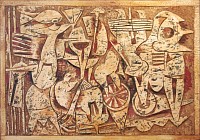BIOGRAPHY

Lucky Sibiya
(b. 1942, Vryheid, South Africa)
Born in Vryheid, South Africa in 1942, Lucky Sibiya was internationally renowned for his abstract paintings and sculptural carvings.
The artist's fascination with the abstract began in his childhood, partly due to his presence at his father's consultations as a Sangoma. Here strange and beautiful artefacts were used to assist in diagnostic and traditional healing medicine.
The destruction of the colourful neighbourhood of Sophiatown during the Fifties resulted in the Sibiya family relocating to Soweto. During his school years he was sent away to Hammanskraal where the young boy experimented with woodcarvings. Shortly before completing his school education at St. Peter's Seminary, Lucky introduced himself to Cecil Skotnes, armed with some of his painted 'found' objects. Skotnes was at this time one of South Africa's foremost contemporary artists. He was head of the Polly Street Art Centre in Johannesburg and he promoted young talent. Skotnes was enthusiastic to accept Sibiya as a private pupil. His mentor's engraved paintings were influential in Sibiya's decision to paint on carved wood.
Sibiya took folk art to its most expressive and sophisticated levels. By rubbing powdered pigments into richly engraved images, Sibiya's compositions progressed from purely decorative to a conceptually abstract vision. As the artist matured, his leaning to carve, rather than to engrave, presented what would emerge as Sibiya's unique signature. The most distinctive features of his style are his use of organic shapes which are connected with flowing, rhythmic lines, juxtaposed on a background of complex carved and painted relief and intaglio spaces.
For the last thirty years of his life his work moved towards more deeply carved studies on a two dimensional plane and working the wood into an almost three dimensional art form. Compounding this form was his addition of intricately worked found objects. These include clothing, steel, leather and richly rusted metals. Over the years he devised a language of abstract symbols; unique and instantly recognizable.
The physical demand of Sibiya's technique was matched only by the harmonious, spiritual feeling experienced when transported into his world of ritual. Key elements of his figurative work include ancient tribal traditions and rites of passage.
In addition to his contribution to the visual arts, Sibiya also contributed to the performing arts with his portfolio illustrations of classic drama. His work, inspired by Welcome Msomi's adaptation of "Macbeth" was highly acclaimed at that time and travelled to the Royal Ceasaria Theatre in Israel and the Old Vic Theatre in London. This Umbatha portfolio was well received in Australia where it featured at the South African Exhibition in Canberra.
Lucky Sibiya tragically passed away in a road accident on 24 January 1999.
SELECTED SOLO EXHIBITIONS
1999
Memorial exhibition, Everard Read, Johannesburg, South Africa
1996
1991
1989
1987
1984
1976
1975
1974
Manzini, Swaziland, South Africa
1973
1972
1971
SELECTED GROUP EXHIBITIONS
Sibiya participated in numerous group exhibitions held throughout SA and in Swaziland, the UK, Australia, Botswana, France, West Germany and the USA. He was invited to participate in "Historical Perspective of Black Art in South Africa 1930-1986", Alliance Francaise, Pretoria and "The Neglected Tradition" an exhibition held at the Johannesburg Art Gallery in 1988-89. The Everard Read Gallery - "South Africa's finest painters" April 1996
SELECTED COLLECTIONS
Arts Association Namibia Collection
Durban Art Museum
Sandton Municipal Collection
South African National Gallery, Cape Town
University of Fort Hare
University of the Witwatersrand
William Humphreys Art Gallery, Kimberley
Bureau of Information, Pretoria
Africana Museum, Johannesburg
SA Broadcasting Corporation, Johannesburg
Berliner Missionwerk Library, Berlin, Germany
Municipal Library, Sasolburg
National Museum and Art Gallery, Gaborone, Botswana
Vaal Administration Board, Sebokeng, Transvaal
The Campbell Collections of the University of Natal, Durban
Numerous Corporate Collection in South Africa, the UK, and the USA.
The Gauteng Legislative Assembly
PUBLIC COMMISSIONS
BIBLIOGRAPHY
BOOKS
E J de Jager, "African Art", 1979, Cape Town
Esme Berman, "The Story of South African Painting", 1974, A A
Balkema, Cape Town
Hans Fransen, "Three Centuries of South African Art", 1982, Ad
Donker, Johannesburg
Esme Berman, "Art And Artists of South Africa", 1983, A A
Balkema, Cape Town
Matsemela Manaka, "Echoes of African Art, A Century of Art in
South Africa", 1987, Skotaville Publishers, Johannesburg
Grania Ogilvie, "The Dictionary of South African Painters and
Sculptors", 1988, Everard Read Gallery, Johannesburg
MAGAZINES
"Artlook", June 1973
"Habitat", no.17, 1975
"SA Panorama", July 1982 & June 1983



